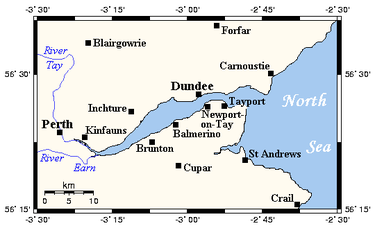U.K. Ministry Of Defense Polluting Seas Off Scotland
I have blogged before about the careless disposal of nuclear wastes in the world's oceans and seas. Nuclear powers used them like sewers with little thought of the possible environmental impact. A great deal of nuclear research and nuclear weapons development has been conducted in Scotland from the end of World War II up to the present. The extent of the nuclear pollution of the seas around Scotland is still being revealed.
The Tay Estuary lies on the east coast of Scotland near Perth. Over seventy five thousand aircraft dials coated with radium were dumped into the Estuary after World War II. Ferranti Limited, a company that manufactured tubes for radios made a deal with local fishermen to dump barrels containing thirty five thousand luminous watch dials painted with radium into the Tay Estuary in 1949. For the next eight years, it is estimated that about five thousand luminous dials were dumped into the Estuary every year. Although the government had warned the company that it needed to get permission to dump waste there, the company simply went ahead and dumped the waste without permission.
Dalgety Bay is a coastal town in Fife that lies to the south of the Tay Estuary. During the 1950s, radioactive waste from a nuclear reactor in Dundee was dumped into the sea near Dallgety Bay. A beach in the town has been found to radioactive. During the 1960s, nuclear waste from nuclear submarines was dumped into the Firth of Forth, an estuary near Edinburgh.
In 2012, there was an incident at the Vulcan naval reactor in Caithness which resulted in the leak of radioactive materials. The Ministry of Defense is currently exempt from government regulations on radioactive pollution and did not make details of the Vulcan incident known until recently. The Scottish Environmental Minister has promised that he will end the immunity of the Ministry of Defense from government regulations.
Now the nuclear submarine bases at Faslane and Coulport near Helensburgh are requesting authorization to raise the limits on the quantity of radioactive wastes that they are allowed to release into the water and air near the bases. There are currently five nuclear submarines based at Faslane naval shipyards but that number is supposed to rise to fourteen submarines by 2019. The MoD wants permission to dump more liquid waste from the submarines into the Gareloch Inlet on the west coast of Scotland. The waste contains cobalt 60 and tritium.
There are nuclear weapons stored at Coulport on Loch Long. Emissions of tritium gas from the warheads has been increasing for years. It will increase even more after the MoD begins storing a new type of warhead at Coulport. The MoD is requesting permission to release more tritium gas at Coulport than is currently permitted.
The MoD claims that these requests are within authorized limits but the Scottish Environmental Ministry wants to wait until it receives new regulatory power that will start soon before any authorization for new MoD releases. However, if the vote to secede from the UK is successful this September, Scotland intends to send all the nuclear submarines and nuclear warheads in Scotland south to Britain. In this case, the requests for increased radioactive emission limits would be moot.
Tay Estuary:
